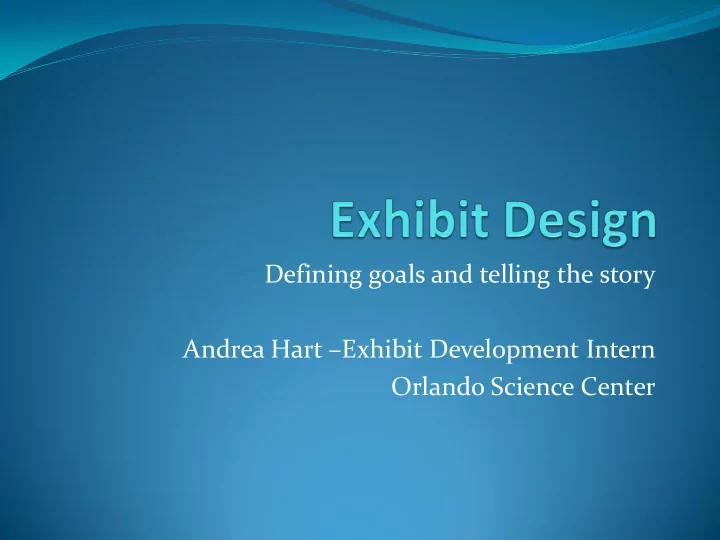

Defining goals and telling the story Andrea Hart – Exhibit Development Intern Orlando Science Center
Educational goals Cognitive Affective Performance: Developing skills Social goals
Example, goals expressed as a message: “I never knew that sharks were endangered!” Original goals: Visitors will recognize that sharks are endangered. (cognitive) Visitors will care about sharks. (affective)
Writing your goals Be specific in your goals and messages with one idea per line Use definitive language in your goals “the visitor will …” Your goals, objectives, messages, must have measurable or observable outcomes Don’t be overly specific in your goals, you don’t want to make visitors feel right or wrong Don't outline the exhibition contents in your goals area. These will appear in your storyline.
Which is the better goal? Visitors will learn how a body is preserved in a peat bog . Visitors will understand that peat preserves things from decay.
Which is the better goal? Visitors will know that iron meteorites contain taenite and kamacite crystals. Visitors will know that iron meteorites are made up of metal compounds not found on earth
What types of goals are these?
I never realized there was a difference between a rainforest and a jungle.
The most dangerous creatures in the ocean are not necessarily big.
We should recycle more items rather than throwing things away.
I did not know that the same elements that cause rubies to be red cause emeralds to be green.
Visitors will test variation in wheel sizes to determine which ones make a faster solar car.
Jelly fish are cool!
Visitors will assemble and disassemble the jointed wood examples to understand that nails were never used in Ming woodworking.
Quantifying your goals You are creating goals that will help in evaluating whether your exhibit is successful or needs refinement If you were to write a questionnaire that your visitors would take after using your exhibit, what percentage of your goals would be retained?
Types of questions in a survey Open-ended questions- -allow visitor to word things in their own way Closed questions , often referred to as multiple choice. These include two subgroups: Checklists- -allow visitors to select one response or as many responses as are applicable Scales --used to determine values such as frequency , intensity , quantity and quality
How questions reveal the success of your goals Example goal: Visitors will understand that most species of sharks are not man-eaters. Quantifying question: Do you agree or disagree that most sharks are man- eaters? Agree Somewhat agree Somewhat disagree Disagree
If you survey 20 people 2 people agree 4 people somewhat agree 8 people somewhat disagree 6 people disagree Therefore 70% of your visitors either somewhat disagree or completely disagree with this statement showing that your goal was successfully perceived
Now your ready to design!
Exhibit storyboard Create a written or visual account of what the visitor will experience Write up a step by step guide i.e Visitor walks up to display and sees a dial, button, and joystick. When the visitor presses the button x happens…. Or sketch a literal story board of what your exhibit will do
Preparing your budget Based on your sketches figure out how much material you need: i.e. how many sq ft of, wood, plexi, metal, plastic Special component costs Wiring costs As a separate item include anticipated maintenance cost If supplies need to be replenished provide a yearly cost
Recommend
More recommend